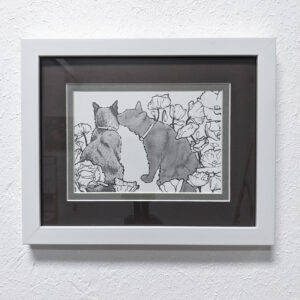How to Keep Your Fine Art Prints in Perfect Condition
So, you finally connected with an artist and purchased a print—now what? You might be tempted to tack it straight to the wall (that’s what I did at first!) or leave it stashed on a shelf in your closet. However, how you handle and display your fine art prints can significantly impact how long you will be able to enjoy them.

Fine Art Print Quality & Why It Matters
Understanding the types of printers and materials used in creating art prints is crucial. There are two main types of printers in the commercial printing industry: laser and inkjet.
Printers & Ink Types
- Laser Printers: Used primarily for text documents and graphs, laser printers are affordable and produce bold colors. However, prints from laser printers don’t retain their quality beyond 25 years, especially when exposed to sunlight. This is because laser printers use dye-based inks, which are more susceptible to sun damage.
- Inkjet Printers: These use pigment-based inks, which make it harder to achieve bright colors but last twice as long as dye-based inks when paired with high-quality paper.
- Giclée Prints: These represent the highest quality in fine art reproductions. Created using specialized and expensive printers paired with archival rag paper, giclée prints can last a lifetime if properly cared for.
Archival-Grade Materials
When materials are “archival-grade,” they are made to last a lifetime, often longer. Archival inks and paper are acid-free, making them resistant to UV deterioration and preventing the paper from breaking down over time.
Shipping & Handling Fine Art Prints
To avoid receiving damaged artwork, check the seller’s packaging and shipping methods. Ensure the studio is smoke-free, the packaging is waterproof, and the print will be shipped in a rigid mailer to prevent bending.
Avoid Exposing Fine Art Prints to the Elements
UV Damage from Direct Sunlight
UV radiation from the sun can degrade the ink on paper, leading to a reduction in quality over time. Avoid displaying art in places where it will receive direct sunlight.
Moisture & Climate Control
Humidity can damage art prints, causing ink bleeding, warping, and mold growth. Store your art in a climate-controlled environment, and be cautious about displaying artwork in bathrooms without proper ventilation.
Scuffing, Oils, and Dirt from Human Hands
Avoid touching your art prints, as oils, dirt, and other particles from your hands can damage the paper and ink. Look with your eyes, not your hands.
Displaying Fine Art Prints in Your Space & Proper Storage
Displaying Your Fine Art Prints at Home
Frame your art prints to protect them from dirt, moisture, and debris. While frames can be expensive, even mass-produced ones can provide essential protection. For optimal preservation, invest in an archival frame with UV-resistant glass.
Proper Storage
Archival storage solutions are affordable and accessible. Options include archival portfolio folders, which act as flipbooks, and rigid archival storage boxes, ideal for extensive art collections. Use glassine sheet protectors to prevent prints from sticking to each other.
Wrapping This Up
After seven years of creating fine art and printing reproductions, I’ve learned a great deal from my own failures and other artists alike. Remember that print quality matters, avoid exposing art to the elements, and protect your art behind glass once it’s home. Whether you’re a skimmer or a deep diver, I hope you learned something valuable today.
Want to stay updated and never miss a blog post? Subscribe to be the first to know when one is published! Learn more about me here.


This is so insightful!! Thanks
So glad I could help!